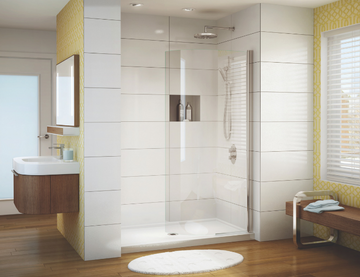

Bathrooms are the perfect breeding ground for mould. Mould is most likely to build up in damp, poorly ventilated areas 'cause all mould needs to thrive is moisture and a lack of ventilation, and once mould has taken hold in your bathroom, it can be difficult to permanently remove it.
Long-term exposure to mold spores can lead to some pretty serious health problems, ranging from mild allergic reactions all the way up to respiratory problems and lung damage. The cause of these health problems is the "mycotoxins" produced by mold, which act as toxins in the body. For this reason, it is important to try and prevent mold before it takes over your bathroom.
Where is mould likely to build up in the bathroom?
The places you'll most likely find mould are:
- Window ledges
- Bath edges
- Tile grout
- Ceiling corners
- Outward facing walls
- Shower enclosure fitting points
- Directly above a bath or shower
How To Prevent Bathroom Mould
1.Keep your bathroom well ventilated
Ventilation is absolutely paramount for preventing future mould growth in your bathroom as mould growth is encouraged by moist areas. If you have a built in extractor fan in the bathroom, try and turn it on during your bath or shower and leave on for 15-30 minutes afterwards. This will ensure that any excess moist air in the room is removed and help the room to dry much faster. If you don’t have a bathroom fan installed, open a window let all the moist air out of the room after you’ve finished in the bathroom. You also can place a container of damp control crystals in the room and replace regularly.

2.Get rid of excess moisture after bathing or showering
In addition to continuing to turn on the extractor fan for 15-30 minutes after bathing or showering, you will also need to clean and dry the bath, sink, shower and all other wet surfaces. Hang towels and bathroom rugs to dry immediately after use. Pull out the shower curtain to its full length to allow it to dry.
3.Check For Leaks & Blockages regularly

Sneaky leaks in the bathroom can be contributing to mould growth without you ever noticing. Leaky toilets and taps are a breeding ground for mould, so if you start to notice a damp, musty odour, take action straight away. Look for leaks around the base of the toilet and around the bottom of taps where the seal may have deteriorated. Take off the bath side panel and check underneath for leaks around pipes which may be dripping onto the floor. Areas which can be missed during regular cleaning include shower fixtures and fittings or tile grouting and sealant, so make sure you check these for those tell-tale black stains.
Once you find black mold anywhere in your bathroom, act quickly to remove it and stop it from spreading. You can use white vinegar or bleach, but for severe mold outbreaks, specialized commercial mold removal products are a better solution. These products can be sprayed or wiped on, allowed to work, and then rinsed off. Use these products carefully and always cover your clothes and hair, especially when using sprays on the ceiling. Keep the room ventilated while using them.
Wear rubber gloves, as stronger mold removal products can harm your skin. Strip off any moldy sealer or grout, clean the area with a removal product or bleach, then re-grout any tiles, dry completely and reseal.
4.Regular Cleaning
A dirty bathroom can encourage the build-up of both bacteria and mould growth. Taking the time to give the bathroom a weekly clean can reduce the likelihood that you’ll ever have a mould problem. Make sure that you remove as much dust as you can as this is a food source for mould and will encourage growth.

The bath mat, bathroom rug, and towels are ideal mold growth spots, especially if you leave them unwashed for long periods of time. One easy way to help fight mold in your bathroom is to wash your towels and bathroom rugs regularly—at least once a week—and together.
5.Keep Your Shower Items Outside The Shower And Dry Them Out
Shower gel and shampoo bottles placed on the side of the tub are perfect breeding grounds for mold growth. To help prevent mold growth, keep bottles and other shower supplies on a shelf or in a basket. And remove them from the shower when not in use.
6.Use A Squeegee

In fact, taking a minute to run the squeegee on your tub or shower walls right after washing reduces the moisture in the room by up to 3/4. That's a lot of dampness you can get rid of and a lot of mold you can prevent.
Final words
As an old saying goes, prevention is easier than cure——so it’s always best to prevent your bathroom from mould in the first place. As with every prevention method, the best way to avoid mold is to avoid the conditions in which it grows in the first place. This means removing water and moisture from the air, keeping fabrics clean, and avoiding water buildup.




